By Dan Wooding
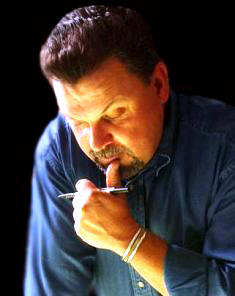
When I first heard the news that popular California artist Thomas Kinkade, 54, had died of natural causes on Friday (April 6, 2012) at his home in Los Gatos. California, it brought back memories of the time I first met Kinkade and later interviewed him.
Some 13 years ago, I had been invited to speak at the Home Church, in Campbell, California, which had started through the ministry of Pastor Mike and Trisha Kiley and calls itself a “multi-ethnic, multi-generational church, with strong emphasis on reaching out to our local community.”
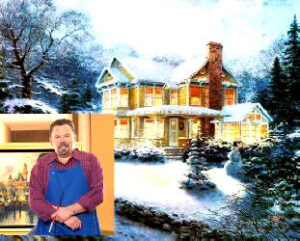
At the end of the service, I was introduced to Kinkade who, at the time, was the church’s most well-known member, and I asked if he would grant me a phone interview, which he did a few days later.
In this rare interview, Kinkade, who is America’s most collected living artist, a painter-communicator and whose tranquil, light-infused paintings brought hope and joy to millions, talked about the basic values of family and home, faith in God, and the luminous beauty of nature. He also challenged others to use their talents for God.
Kinkade said that he credits the Lord for both the ability and the inspiration to create his paintings.
“My goal is to touch all people, to bring peace and joy into their lives through the images I create and I see my art as a ministry tool to share Jesus Christ with the masses,” he said.
Kinkade went on to say, “I became a Christian in 1980, when I was about 22 years old, and I would say that when I was saved, my art got saved. It was then that a very interesting transition began in my life. I started to see the characteristic of light begin to develop within my work. The darkness was leaving and the light was beginning to break forth. For example, my paintings, prior to that time, were very much self-defining and idiosyncratic. They were very much my own expression.
“I had little interest in how my art affected other people. In fact, my college professors would constantly make the point that one’s art is
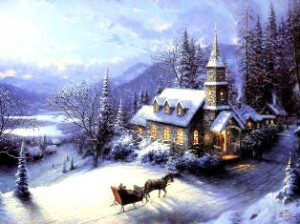
all about one’s self. It doesn’t matter if someone else understands or likes it. It doesn’t matter if they purchase it. All that matters is you.’ It was art as self-expression, as opposed to any concern for, or consciousness of an audience, or any desire to impact other people.
“When I became a Christian, I began to challenge that notion. To this day, I find it odious that that notion is fostered within the arts. It is very self-serving and a self-absorbed kind of approach to creativity that really is ineffective. In fact, artists have fought the wrong battle over the past 75 to 100 years. The battle has been one for the freedom of expression, the battle to obtain freedom of expression. Well, artists have won that battle but, in the meantime, they’ve lost the war for cultural relevancy and a positive impact on society.
“There was a time when artists were cultural leaders, revered within society as visionaries, people who might point the way to a better world, a better life. America’s nineteenth century landscape painters embodied the notion of eminent domain, for example their visions of the overwhelming, overpowering beauty of vast landscapes of the American West were captured in paintings that, to the common imagination, became icons of Westward expansion. They became messages of America’s power that was yet untapped; a very powerful, constructive form of art that really symbolized the times. I could cite dozens of other examples where art was not only a part of society, but when the artists became important leaders in society.
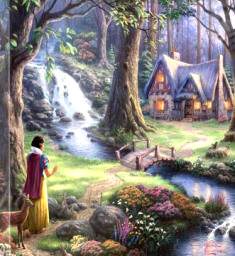
“All that began to change with the advent of hyper-individualism in the late 19th century, which said one must be apart from society. An outsider, like a gypsy, almost removed from society. For an artist to ever say that he desires to have his work accepted, would also most be considered to be an insult, or even a statement of naïveté on the part of an artist. Yet, secretly, that’s what every artist really desires. Not only to be accepted, but also to have their life and their work mean something.
“I also think that if you search the roots of creative expression, you will find that in many cases, the artist creates in today’s world out of a deep need, out of a pain or out of a lack in their life. This is the opposite to what began to emerge in my art, after I put Christ in the center of my life, I had an overflowing of joy; an overflowing of peace and an overflowing of passion for living that began to find itself expressed through my canvases. And so, rather than creating out of a need, or out of lack, or out of a pain, or a desire to be noticed, I created out of this servant’s heart, a desire to pour onto the canvas, something that is bubbling up within me; the well of joy that was now in my own life. And to serve others with that joy and to create for others, visions of peace, tranquility and God’s love.”
I then asked Kinkade, how he became known as “The Painter of Light?” and he replied, “That just emerged because of the themes that were in my paintings. There was no other handle that could describe my creative vision. Some artists say, ‘Well, I paint ships.’ Someone else will say, ‘I’m an animal painter.’ I don’t paint any particular genre or subject. I paint anything within the visible world, particularly anything within the external world – outdoors. I like creating worlds were nature is flowering. I love visions that are almost idyllic in their conception, so to me the logical starting point in expressing the world of beauty is light. Light is a force by which all things become visible. And, as I began noticing light emerging more and more in my work, I began being known as the ‘Painter of Light.’
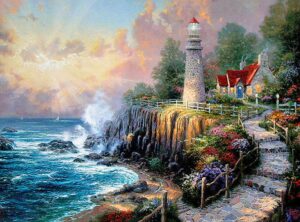
“I have, since that time, really studied scripture and I’ve discovered how light is a fundamental expression of God’s character. In fact, it’s the first thing that He declares to be good in scripture. In Genesis, Chapter One, we see Him creating light. The first sentence in scripture that is attributed to God is ‘Let there be light…’ And then, following that He makes the statement, ‘…and He saw that it was good.’ We know that light is foundational in God’s character. Christ is described as ‘the light of the world.’ Christ told us to be lights and that we are a ‘light on a hill.’ We are to ‘let our light shine before men so they could see our good works and glorify our Father in heaven.’ Well, all these scriptures point to the fact that light is characteristic of God and I believe it should also be characteristic of believers and so, in my paintings, it’s a literal fulfillment of that scripture. We can really see light take on a transcendent quality within the paintings, not just as a visible evidence of material things illumina ted by the force we call light, but as a spiritual dynamic within the painting. When people see that light, it’s not just the visible light they see, but it’s a spiritual light, too, that really touches the inner darkness of their soul.
“As a result, we receive hundreds of letters a year from people who write, not to comment on the technical aspects of the paintings, but to comment on how God has warmed their heart or changed their life through that painting.”
A Tribute to Nanette
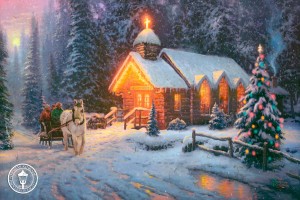 I then asked him about the story that he hides the letter “N” within his painting to pay tribute to Nanette, his wife and childhood sweetheart. His daughters also find their names and images in many of his paintings. They are all named after famous painters: Merritt, Chandler, Windsor and Everett.
I then asked him about the story that he hides the letter “N” within his painting to pay tribute to Nanette, his wife and childhood sweetheart. His daughters also find their names and images in many of his paintings. They are all named after famous painters: Merritt, Chandler, Windsor and Everett.
“When I started publishing prints, I viewed it as a joint effort,” explained Kinkade. “My wife Nanette and I took our life savings and printed our first print in 1984, and when we published that print, I had this idea to put a little tribute to Nanette within the painting. One of the dealers that was carrying the print, found out about this and began to point it out to collectors. So when I released the next print, the dealer, of course, called me and asked me where the initial ‘N’ was in that painting and I said, ‘There wasn’t one. I did that as a tribute to my wife, because we did our first print.’ He said, ‘Gee, you’ve got to put ‘N’s’ in the painting as the collectors love it. So I started putting it in the painting just for fun and it has grown to be a curious phenomenon in that the collectors look for it in each painting. I now put a little number by my signature, too, which tells you how many ‘N’s’ are in each painting.
“I’ve actually had people come up to me and say, ‘Tom, I’ve found 15 ‘N’s’ in this painting and I’ll think to myself, “Well, I only put one or two in it.” So I’ve had to put a number by my signature to give people relief so they could know how many are really there. Kids get involved with this, too, and it really becomes a little form of communication.”
The Art of Simplicity
I then asked Kinkade how he felt that people make their lives simpler?
He said, “I wrote a book called ‘Simpler Times’ about this subject, which is very dear to my heart. I believe the foundational challenge in
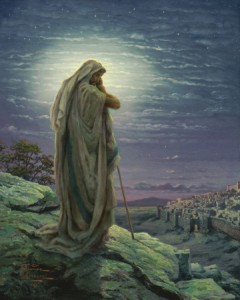
life in our culture, at least, is not the challenge for more material attainment, because we’ve won that battle. As a culture we have great material resources. It’s not the battle for comfort and warmth and food. Most of us have no problem in providing for those basic needs. But the real battle is for the identity of the soul; the real characteristic elements of a life of satisfaction versus a life of stress and over-anxiousness through over-commitment. Most people are just too busy and their life spins out of control in frenzy and I began to see that happening in my life as more and more commitments would weigh in on my daily schedule and I would lose time with my family in favor of these commitments that had to be met and I just decided that there must be some ways, some simple tools, to bring back to my life those foundational life elements, those peaceful times with my family.
“Those simple moments of walking in the neighborhood and riding the bicycle and taking time to read a book. Simple things that enhance life and give your life balance. So I began learning techniques to do that and then studied it quite actively and then wrote a lot of my findings in a book. But I think some of the real foundational things are the questions about the activities that are stealing time.
“One of the basic things that we did in our life was that we eliminated the television and that’s a radical thing for most people because it is a drug-like addiction that people have to that, as a form of relaxation they have in the evenings. But it is a kind of stressful element in the life because people become hooked on certain shows, which create commitments, which you have to be there because you can’t miss this latest show. And when we got the television out of our home, which was just a couple of years into our marriage, we found that we had so much time for things we really liked to do. I don’t have any particular moral objection to television per se. It is a neutral media that is neither good nor evil. However, it can be either, depending on the content. But as a medium it is neutral.
“Therefore, television is not to me intrinsically evil, but to me it is a thief of time.”
The Kinkade family live in a village setting
“We made a deliberate choice to live near the center of the village so that we can walk into town to get a cup of coffee or go to the candy store, which has a big tree where we go to enjoy the candies and it really creates a simple life,” he said. “We also do a lot of games and a lot of reading. We have a family devotion that we do on a regular basis, where the kids pray and we pray with them. These are simple things to do, yet they don’t cost any money and you’d be surprised when people say, ‘Oh, that’s easy for you because you’ve become successful and you’re artists and you have all these freedom.’ That’s completely untrue. It’s accessible to every person and every family to simply substitute a non-productive stress-inducing behavior with those that create a sense of peace and well-being and closeness to God.
“We are in a post-verbal, post-written-word society. We are fast approaching an image-based society. It is very interesting to see that reading as a skill is probably sustaining itself at a certain level, but reading as a recreational activity is declining. People are surfing the Net or spending time watching television or renting videos rather than spending time with a good book. As a result, the era when you could write a Christian book and hope to change the world is changing. The power of the written word is being weakened and that should not be a scary thing for the Christian Church because ultimately, God’s Word, though it is a written word, is only of power when it is enlivened by the Holy Spirit in the hearts of men. It is truly the Holy Spirit that communicates with us and not text printed page. But having said all of that, I believe we are entering an era where new and exciting formats for spreading the Gospel will be very relevant to people. I think we should not be afraid of the Internet. We should embrace it and be a force of light on the darkness of the Internet as a Christian Church.
“The same is true of with paintings. It’s very interesting how powerful these paintings have become in people’s lives. I’ve analyzed it a little bit and I will tell you that when I committed my talents to the Lord, I really believed He began to prepare a ministry for me. I didn’t have any idea how he was doing it and couldn’t see the pieces falling into place, but He was doing it nonetheless.
“When it began to emerge was that God would touch people through these paintings and it began to be obvious to me that something bigger than me was happening here. People would have physical healings in front of the paintings and they would write to share that they had had a salvation experience and had come to know Jesus while standing in front of one of these paintings. People who were in deep despair and depression, got hope through the paintings. People who went through mild times of stress had a new sense of purpose in their lives. People who had lost a love one, could glance at that painting and feel reunited with that heart of their dear departed. These are phenomenal stories so what this caused me to do was to analyze what was happening here. And I began to think about the nature of created communication because all created work form a communication with another person.
“For instance, a piece of music is a very powerful form of communication, but if you think about it, it is limited by the element of time. You listen to music and it touches your heart. Your heart can sore when you hear that music, that inspirational song, but yet, very soon the song is over, and you put the CD up on your shelf.
“A book you can read. It enters you into a world of imagination. You can step into that world and be touched but at a certain point, the book is over, you put it on the shelf and the same is true of a motion picture.
“Now a painting is different. It is not limited by the element of time. It is a permanent part of the home. It enters the home and becomes a part of the family culture and it hangs on the wall forever and although you don’t enter it for prolonged periods of time, it becomes an imprint on your visual environment. You are looking at it continuously. So the images we gaze upon enter the heart, because the eye is the gate to the heart and it’s very important what we gave upon and the Word is very specific about that. That we must guard the entrance to the heart. The Bible says, ‘For as a man thinketh in his heart, so is he.’
“So I believe that the ministry that I have as a painter simply a ministry of bringing into the heart, images of peace and serenity that people to the world as God intended it to be, not the world that man has made it through his destructive, sinful nature; a world that is at peace and in balance and harmonious. My paintings are extremely idealistic and I don’t apologize for that.”
Thomas Kinkade concluded by saying, “It is overwhelming and miraculous to me to think that God could have chosen to use an artist. When I got saved, I asked God to use my talents, the whole of me in any way he could, but honestly I was really suspicious that there was no possible way that God could use an artist. I knew he could use a preacher, or if I wrote books, He could use me, or if I was a singer, but I couldn’t think of a way that God could use an artist. Art is kind of on the fringe. Nobody really is in art anymore.
“Yet God really used my paintings to change that and to introduce millions of people to the enjoyment of a painting as a tool within the home to enhance the life of the individual and to enhance the lifestyle and the hope and to give people a sense of vision of a better world. You know I didn’t plan all of that, but it does bring up the point, whatever talents we may have, even if you think it is the most obscure thing you can imagine that God could possibly use, just commit it Him because we were all pre-packaged at the time of salvation.
“It is not an accident, the talents, the skills that we have and we have a talent in repairing refrigerators, the chances are that God can use a refrigerator repair man as a minister of the Gospel. That may sound crazy, but if He can use an artist, He can use anybody!”
Now Thomas Kinkade has left us, but his legacy lives on with his paintings now hanging in an estimated 1 out of every 20 homes in the United States alone, providing light and hope to so many.




Mr. Kinkade was given a beautiful gift and his paintings gives us a glimpse of the way that God wanted this world to look like. So much beauty and peace, sadly far too many of us don’t appreciate God’s gift of nature. My heart goes out to his family as I know from personal experience, what it is to ‘lose’ a loved one at this time of the year. Our married daughter left us on Holy Thursday, April 9th, 2009ad, and they never did find out what was the cause of her death. Sad and painful, but we know that when they leave us, if they are right with God, their final home will be in Heaven. Thank you Mr. Kinkade, for giving us such wonderful paintings and they put the highly over-rated Mona Lisa to shame. May the Glory of this Easter Day shine in every one’s heart. +JMJ+
RIP, Thomas Kinkade. What a very special soul you are!
Truly heavenly inspired — radiant beauty!!
God Bless his family — till they meet again!!
For many years now I have been taken by the hauntingly beautiful painting of Mr. Kinkade. One had only to observe the beautiful depection of light in his work, to know that he had the light of our Lord Jesus in his heart and soul. I was very saddened to learn of his passing. My heartfelt prayers go out to Nanette and the girls. I, too, know the pain and heartache of losing a husband at an early age. My husbnad was 59 when God called him home. The world was such a happier, better place because of Mr. Kinkade’s art. He will be greatly missed.
While I’ve always liked Thomas Kinkade’s art, I’ve never purchased anything other than a puzzle. I regret this fact, because now that he’s passed away, his paintings are likely to become unaffordable! A great loss, may he rest in peace.
I feel like I could walk up the steps of his paintings and open the door and go in and have a cup of tea! They are so inviting and real. May Jesus Christ be Praised! We will miss you Tom …
Nice article. Thanks for sharing.
Comments are closed.